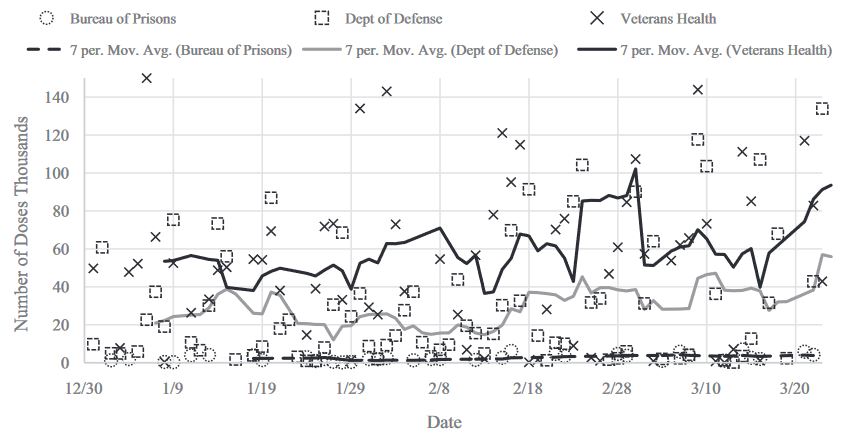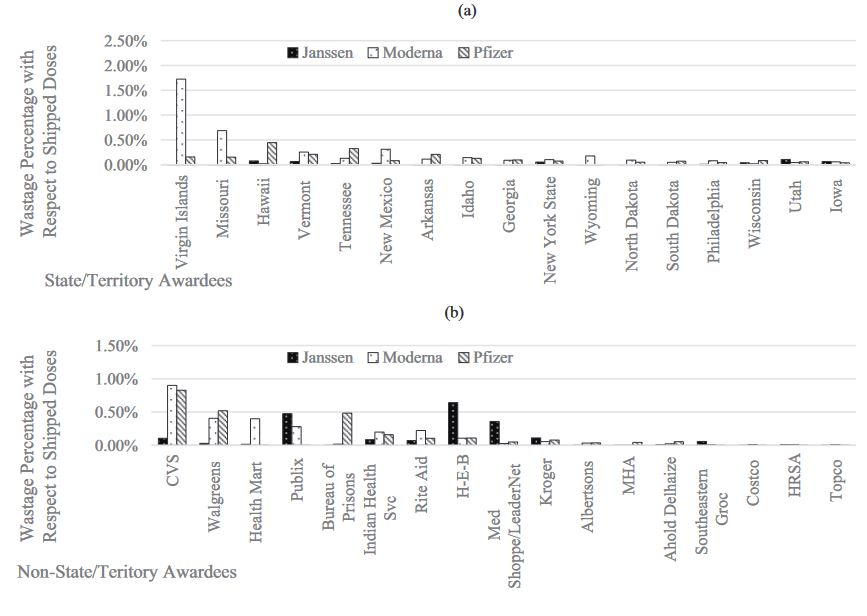Some Wastage Noted at Indian Health Service

Number of Doses Shipped over Time to the Department of Veterans Affairs, Department of Defense, and Bureau of Prisons Source: Informs PubsOnLine
RALEIGH, NC — In an effort to improve future efforts, data has been made available on initial COVID-19 vaccine shipments and wastage across the United States, which occurred shortly after those vaccines became available.
The goal wasn’t to place blame, according to the study team, but, among the findings was that CVS and Walgreens had the most wastage followed by much lower – but still significant—amounts at Rite Aid, the Indian Health Service, Publix and Kroger. At the same time, among the states, Missouri had the highest percentage of doses wasted, followed by Tennessee, New York, Georgia, Arkansas and New Mexico.
Reporting of the data was part of a collaboration of NC State University with BuzzFeed News.
“The development and distribution of COVID-19 vaccines has been a monumental undertaking,” said corresponding author Ali Hajbabaie, PhD, an assistant professor of civil, construction and environmental engineering at NC State. “And while it’s been a remarkable accomplishment, there are also opportunities for us to learn how to improve the vaccine supply chain. What are the logistical challenges associated with transportation and distribution of vaccines for COVID-19? How can we study this? What can we learn from it?”
Co-author Leila Hajibabai, PhD, added, “For this work, we focused on collecting data regarding vaccine shipment and wastage. And we’re making that data publicly available to encourage the broader research community to analyze the data so that we can learn as much from it as possible. We also want to inspire other researchers to make their data publicly available in a timely manner.”
“We did some simple analyses in this paper to highlight the potential of the data, but we think there is much more to be done, and we want to tap into the expertise of other researchers to make the most of this information,” Hajbabaie noted.

Vaccine Wastage to Shipment Percentage for Different Awardees: (a) State/Territory, (b) Nonstate/Territory Source: Informs PubsOnLine
Vaccine shipment data was collected from the national Centers for Disease Control and Prevention (CDC), including, type of vaccine, the amount of vaccine and the date that each specific shipment was sent to each of 47,188 specific vaccination sites, such as pharmacies, clinics, hospitals and physician offices. The information is from Jan. 1, 2021, to March 31, 2021, early in vaccination efforts.
In the United States, the federal government initially allocated limited supplies of COVID-19 vaccines to three types of vaccine awardees, including jurisdictions, federal programs and federal entities. Jurisdictions include states, territories, freely associated states, tribes or local entities. Federal programs include Federal Retail Pharmacy Program, Health Resources and Services Administration’s (HRSA) Federally Qualified Community Health Center Program, Federal Emergency Management Agency (FEMA) Community Vaccination Center (CVC) Pilot Site and Mobile Vaccination Program and Federal Dialysis Center Program. Federal entities include the Bureau of Prisons, Department of Defense, Indian Health Service and Veterans Health Administration, each receiving its own vaccine allocation.
Pharmacies and other retailers (e.g., CVS, Walgreens, COSTCO and Walmart) also might have received vaccines from jurisdictions.
The study also included data on the amount of vaccine that was spoiled and had to be discarded. Reasons include a broken vial, improper storage or expired product. Wastage data was available for 58 or 92 large vaccines awardees nationally, the authors pointed out.
“This data was not made available outside of the CDC until we asked for it,” Hajbabaie advised. “We were only able to get this data due to a collaboration with BuzzFeed, which obtained the data from the CDC under a FOIA request.”
“In the paper, we outline some directions for future work, such as how to account for vaccine hesitancy in order to optimize the supply chain and distribution network for vaccination moving forward,” Hajibabai said. “For example, we can estimate the demand and waste accordingly and make recommendations to seamlessly schedule patients and reduce wastage.”
The study noted that, within the time period for which data was available, 179.7 million vaccine doses were shipped, and 182,800 doses were reported as spoiled —0.102% wastage. The authors note that 0.0241% of Janssen vaccines, 0.0867% of Moderna vaccines and 0.1221% of Pfizer vaccines were wasted, adding, “This observation is as expected, as the Janssen vaccine does not require storage at a cold temperature, while the Moderna and Pfizer vaccines do.”
While the study showed large pharmacy chains CVS and Walgreens with the highest wastage, researchers point out that those companies “have received a considerable number of doses.” Overall, between them, CVS and Walgreens received 11% of total doses at the time, according to the study.
Researchers pointed out that six awardees recorded around 83% of wasted vaccines, and the remaining 52 awardees recorded 17% wastage based on the data available.
Examples in the study included that 1.7% of Moderna vaccine doses were wasted in the Virgin Islands and, at CVS, 0.1% of Janssen, 0.9%of Moderna, and 0.83% of Pfizer vaccines were wasted.
Neither the VA nor DoD was among entities receiving vaccine which had high levels of wasted doses.
- Hajibabai L, Hajbabaie A, Swann J, Vergano, D. Using COVID-19 Data on Vaccine Shipments and Wastage to Inform Modeling and Decision-Making. Transportation Science. Published Online:1 Apr 2022. https://doi.org/10.1287/trsc.2022.1134


